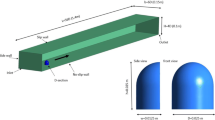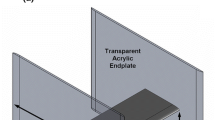Abstract
An experimental characterization of the turbulent flow structure formed downstream of a vertically mounted circular bluff body is performed. Three components of an instantaneous velocity field are measured using the stereo particle image velocimetry technique at the symmetry plane. The average velocity and the turbulent properties are analyzed. The results indicate a recirculation zone consisting of a toroidal vortex with similar dimensions for all Reynolds numbers. The largest turbulent fluctuations are found at the stagnation point region. The observed anisotropy of the normal Reynolds stress components is associated with the stagnation point flow, whereas the cross-correlation component extreme occurs in high strain rate regions. An analysis of the Reynolds tensor anisotropy using the Lumley triangle is performed, revealing that the largest departures from isotropy occur at high shear regions and also within the vortex.
Similar content being viewed by others
References
Masri, A.R., Dibble, R.W., Barlow, R.S.: The structure of turbulent nonpremixed flames revealed by Raman-Rayleigh-LIF measurements. Prog. Energy Combust Sci. 22(4), 307–362 (1996). doi:10.1016/S0360-1285(96)00009-3
Egúsquiza, J.C., Figueira da Silva, L.F.: Turbulent non-premixed ethanol–air flame experimental study using laser diagnostics. J. Braz. Soc. Mech. Sci. Eng. 35(3), 177–188 (2013). doi:10.1007/s40430-013-0017-y
Caetano, N.R., Figueira da Silva, L.F.: A comparative experimental study of turbulent non premixed flames stabilized by a bluff-body burner. Exp. Therm. Fluid Sci. 63, 20–33 (2015). doi:10.1016/j.expthermflusci.2015.01.006
Andrade, F.O., Figueira da Silva, L.F., Mura, A.: Large eddy simulation of turbulent premixed combustion at moderate Damköhler numbers stabilized in a high-speed flow. Combust. Sci. Technol. 183(7), 645–664 (2011). doi:10.1080/00102202.2010.536600
Celis, C., Figueira da Silva, L.F.: On mass consistency techniques used in LES/PDF simulations of turbulent reacting flows. In: 8th Mediterr. Combust. Symp, Izmir (2013)
Vedovoto, J.M., Silveira Neto, A., Figueira da Silva, L.F., Mura, A.: Influence of synthetic inlet turbulence on the prediction of low Mach number flows. Comput. Fluid 106, 135–153 (2015). doi:10.1016/j.compfluid.2014.09.046
Durao, D.F.G., Whitelaw, J.H.: Velocity characteristics of the flow in the near wake of a disk. J. Fluid Mech. 85(2), 369–385 (1978). doi:10.1017/s0022112078000683
Huang, R.F., Lin, C.L.: Velocity field of a bluff-body wake. J. Wind Eng. Ind. Aerodyn. 85(1), 31–45 (2000). doi:10.1016/S0167-6105(99)00117-8
Braza, M., Perrin, R., Hoarau, Y.: Turbulence properties in the cylinder wake at high Reynolds number. J. Fluids Struct. 22(6–7), 757–771 (2006). doi:10.1016/j.jfluidstructs.2006.04.021
Bitter, M., Scharnowski, S., Hain, R., Kahler, C.J.: High-repetition-rate PIV investigations on a generic rocket model in sub- and supersonic flows. Exp. Fluids 50(4), 1019–1030 (2011). doi:10.1007/s00348-010-0988-8
Pope, S.B.: Turbulent Flows. Cambridge University Press, Cambridge (2000)
Chassaing, P.: Turbulence en mécanique des fluides: analyse du phénomène en vue de sa modélisation à l’usage de l’ingénieu. Cépaduès – éditions, Paris (2000)
Uberoi, M.S., Freymuth, P.: Turbulent energy balance and spectra of the axisymmetric wake. Phys. Fluids 13, 2205–2210 (1970). doi:10.1063/1.1693225
Redfor, J.A., Castro, I.P., Coleman, G.N.: On the universality of turbulent axisymmetric wakes. J. Fluid Mech. 710, 419–452 (2012). doi:10.1017/jfm.2012.371
Herrin, J.L., Dutton, J.C.: Supersonic base flow experiments in the near wake of a cylindrical afterbody. AIAA J. 32(1), 77–83 (1994). doi:10.2514/3.11953
Antonia, R.A., Zhou, T., Romano, G.P.: Small-scale turbulence characteristics of two-dimensional bluff body wakes. J. Fluid Mech. 459, 67–92 (2002). doi:10.1017/S0022112002007942
Thiesset, F., Danaila, L., Antonia, R.A.: Dynamical effect of the total strain induced by the coherent motion on local isotropy in a wake. J. Fluid Mech. 720, 393–423 (2013). doi:10.1017/jfm.2013.11
Choi, K., Lumley, J.L.: The return to isotropy of homogeneous turbulence. J. Fluid Mech. 436, 59–84 (2001). doi:10.1017/S002211200100386X
Derksen, J.J., Doelman, M.S., Van den Akker, H.E.: Three-dimensional LDA measurements in the impeller region of a turbulently stirred tank. Exp. Fluids 27(6), 522–532 (1999). doi:10.1007/s003480050376
Hartmann, H., Derksen, J.J., Montavon, C., Pearson, J., Hamill, I.S., van den Akker, H.E.A.: Assessment of large eddy and RANS stirred tank simulations by means of LDA. Chem. Eng. Sci. 59(12), 2419–2432 (2004). doi:10.1016/j.ces.2004.01.065
Raffel, M., Willert, C., Wereley, S., Kompenhans, J.: Particle Image Velocimetry: a Practical Guide. Springer, Berlin (2007)
Roesgen, T.: Optimal subpixel interpolation in particle image velocimetry. Exp. Fluids 35(3), 252–256 (2003). doi:10.1007/s00348-003-0627-8
Adrian, R., Westerweel, J.: Particle Image Velocimetry. Cambridge University Press, New York (2011)
Sciacchitano, A., Neal, D.R., Smith, B.L., Warner, S.O., Vlachos, P.P., Wieneke, B., Scarano, F.: Collaborative framework for PIV uncertainty quantification: comparative assessment of methods. Meas. Sci. Technol. 26(7), 074004 (2014). doi:10.1088/0957-0233/26/7/074004
Benedict, L.H., Gould, R.D.: Towards better uncertainty estimates for turbulence statistics. Exp. Fluids 22(2), 129–136 (1996). doi:10.1007/s003480050030
Lazar, E., DeBlauw, B., Glumac, N., Dutton, C., Elliott, G.: A practical approach to PIV uncertainty analysis. In: 27th AIAA Aerodynamic Meas. Technol. Ground Testing Conf., Chicago (2010)
Melling, A.: Tracer particles and seeding for particle image velocimetry. Meas. Sci. Technol. 8(12), 1406–1416 (1997). doi:10.1088/0957-0233/8/12/005
Durbin, P.A., Pettersson Reif, B.A.: Statistical Theory and Modeling for Turbulent Flows. Wiley, Chichester (2011)
Lumley, J.L.: Computational modelling of turbulent flows. Adv. Appl. Mech. 18, 123–176 (1978). doi:10.1016/S0065-2156(08)70266-7
Author information
Authors and Affiliations
Corresponding author
Rights and permissions
About this article
Cite this article
Cruz Villanueva, J.J., Figueira da Silva, L.F. Study of the Turbulent Velocity Field in the Near Wake of a Bluff Body. Flow Turbulence Combust 97, 715–728 (2016). https://doi.org/10.1007/s10494-016-9709-6
Received:
Accepted:
Published:
Issue Date:
DOI: https://doi.org/10.1007/s10494-016-9709-6




